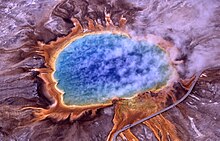yellow. orange. or red pigment oftentimes responsible for those colors in some parts of trees and other plants. Other chemicals also contribute to these colors. including anthocyanins and anthoxanthins.

Carotenoids (/kəˈrɒtɪnɔɪd/), also called tetraterpenoids, are yellow, orange, and red organic pigments that are produced by plants and algae, as well as several bacteria and fungi. Carotenoids give the characteristic color to pumpkins, carrots, corn, tomatoes, canaries, flamingos, and daffodils. Carotenoids can be produced from fats and other basic organic metabolic building blocks by all these organisms. The only animals known to produce carotenoids are aphids and spider mites, which acquired the ability and genes from fungi or it is produced by endosymbiotic bacteria in whiteflies. Carotenoids from the diet are stored in the fatty tissues of animals, and exclusively carnivorous animals obtain the compounds from animal fat. In the human diet, absorption of carotenoids is improved when consumed with fat in a meal. Cooking carotenoid-containing vegetables in oil increases carotenoid bioavailability.
There are over 1,100 known carotenoids which can be further categorized into two classes, xanthophylls (which contain oxygen) and carotenes (which are purely hydrocarbons, and contain no oxygen). All are derivatives of tetraterpenes, meaning that they are produced from 8 isoprene molecules and contain 40 carbon atoms. In general, carotenoids absorb wavelengths ranging from 400–550 nanometers (violet to green light). This causes the compounds to be deeply colored yellow, orange, or red. Carotenoids are the dominant pigment in autumn leaf coloration of about 15-30% of tree species, but many plant colors, especially reds and purples, are due to polyphenols.
Carotenoids serve two key roles in plants and algae: they absorb light energy for use in photosynthesis, and they protect chlorophyll from photodamage. Carotenoids that contain unsubstituted beta-ionone rings (including beta-carotene, alpha-carotene, beta-cryptoxanthin and gamma-carotene) have vitamin A activity (meaning that they can be converted to retinol). In the eye, lutein, meso-zeaxanthin, and zeaxanthin are present as macular pigments whose importance in visual function remains under clinical research as of 2016. There is insufficient evidence to state that carotenoids have an antioxidant function in humans or that carotenoid dietary supplements lower the risk of or prevent diseases.

